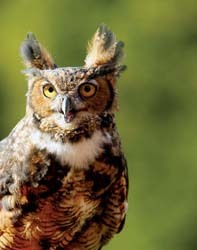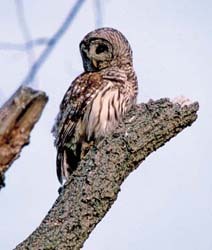Fun Facts About Owls
 The adaptive Great Horned Owl can be found virtually anywhere in North America. Its habitat includes forest, field, tundra and desert and highly-developed suburban areas.
The adaptive Great Horned Owl can be found virtually anywhere in North America. Its habitat includes forest, field, tundra and desert and highly-developed suburban areas.- Owls' feathers are especially soft and muffle wind noise. Many owls also have special comb-like fringes on the leading edge of their wings to help channel air, thereby reducing noise. These adaptations allow owls to make a soundless approach towards their prey.
- An old southern legend states that if you hear a Great Horned Owl’s call coming from your left side it is forecasting bad luck for you.
- Many owls can turn their head around over 270º, allowing them to look almost directly behind themselves. This adaptation compensates for the fact that their eyes are fixed into a boney socket in the skull and are virtually unable to move.
- Owls' eyes are unique among birds as they are located on the front of the head, instead of on the side. This not only gives them a very human appearance but also enables them to match our level of depth perception that is created by the overlapping vision from each eye.
- Owls can fly and hunt during the daytime as well as at night. However most of them are best adapted for nocturnal hunting.
- Owls' ears are located asymmetrically on their head, with the right ear being higher than the left ear. Each ear hears the same sound with a slight difference, creating a form of audible “depth perception” which can be used to track the location and movements of their prey.
 When fully spread out, the talon of a Great Horned Owl can span up to eight inches wide.
When fully spread out, the talon of a Great Horned Owl can span up to eight inches wide.- After digesting their most recent meal, owls will form a pellet of the undigested remains of their prey and regurgitate it. Made up primarily of fur, feathers and bones, it is egested approximately 13-16 hours after eating.
- The Great Horned Owl nests earlier than any other bird of prey in North America.
- When listening to the calls of Great Horned Owls you can distinguish the male from the female by his lower pitch and slightly slower call.
- The Great Horned Owl is probably the longest-lived owl in North America. Banding records confirm numerous owls living into their twenties, with the record lifespan being more than 27 years.

